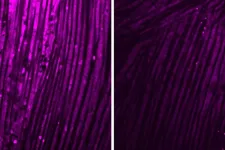UMass Amherst food scientist rises to the challenge of giving marbled fatty feel and taste to plant-based meat
Researcher awarded grant from Good Food Institute to bridge the gap between plant protein and lipids
2024-07-12
(Press-News.org)
One of the challenges of creating realistic-looking and delectable plant-based meat is mimicking the marbled effect of animal fat that many carnivores expect and enjoy.
A University of Massachusetts Amherst food scientist has a plan to tackle this quandary by developing new technology supported by a $250,000 grant from the Good Food Institute. The not-for-profit think tank promotes plant-based alternatives to meat, dairy and eggs, as well as cultivated “clean meat” grown from animal cells in a facility.
The technology proposed by Lutz Grossmann, an assistant professor, “has the potential to revolutionize the plant-based meat industry, expanding its product offerings and appealing to a wider audience,” the institute stated in announcing the grant, one of 118 awarded in 21 countries, totaling more than $21 million, since 2019.
“The Good Food Institute has played a key role in supporting research for more sustainable food options, and UMass Food Science has been fortunate to receive funding,” Grossmann says. In 2020, a team of UMass Amherst food scientists, led by Distinguished Professor David Julian McClements, received a grant from the institute to develop a new approach for creating tasty, plant-based, protein-rich food that’s similar in texture to whole chicken, pork or beef.
Grossmann, whose research focuses on designing holistic approaches to increase the consumption of plant- and microbial protein-rich foods, aims to incorporate lipids into high-moisture extrusion processes, a technique used to replicate the juiciness, appearance and texture of whole-muscle animal meat.
“While high-moisture extrusion has become a primary method for creating meat-like textures from plant proteins, it currently lacks the ability to generate lipid marbling, a key characteristic for replicating the appearance, flavor and texture of traditional meat products,” Grossmann explains. “The challenges of incorporating lipids into high-moisture extrusion processes are mainly related to the lubricating effect of plant lipids that disrupt the protein melt within the extruder barrel.”
In addition, injecting lipids during the cooling part of the process – when the meat-like structure is finalized – results in uneven distribution, leading to suboptimal texture, he adds.
To overcome these challenges and bridge the gap between plant proteins and lipids, Grossmann is developing and will implement a novel extrusion segment that will facilitate the creation of the marbled appearance and texture of plant-based whole-cut meat products.
“The setup basically works like a piping bag that allows for making a two-colored swirl,” Grossmann says.
END
[Attachments] See images for this press release:

ELSE PRESS RELEASES FROM THIS DATE:
2024-07-12
In a revelation that highlights the fragile balance of our planet's atmosphere, scientists from China, Germany, and the USA have uncovered an unexpected link between massive wildfire events and the chemistry of the ozone layer. Published in Science Advances, this study reveals how wildfires, such as the catastrophic 2019/20 Australian bushfires, impact the stratosphere in previously unseen ways.
The ozone layer, a crucial shield protecting life on Earth from harmful ultraviolet (UV) radiation, has been on a path to ...
2024-07-12
Infections and neurodegenerative diseases cause inflammation in the brain. But for unknown reasons, patients with brain inflammation often develop muscle problems that seem to be independent of the central nervous system. Now, researchers at Washington University School of Medicine in St. Louis have revealed how brain inflammation releases a specific protein that travels from the brain to the muscles and causes a loss of muscle function.
The study, in fruit flies and mice, also identified ways to block this process, which could have ...
2024-07-12
Researchers from University of California San Diego have found that two of the most frequently administered stem cell therapies, which are often used interchangeably, actually contain completely different types of cells. The results challenge the current “one-cell-cures-all” paradigm in orthopedic stem cell therapeutics and highlight the need for more informed and rigorous characterization of injectable stem cell therapies before they are marketed for use in patients.
The researchers analyzed cell populations of autologous bone marrow aspirate concentrate (BMAC) and adipose-derived ...
2024-07-12
The ozone layer, a crucial shield protecting life on Earth from harmful ultraviolet (UV) radiation, has been on a path to recovery thanks to the Montreal Protocol. This landmark international treaty, adopted in 1987, successfully led to phasing out the production of numerous substances responsible for ozone depletion. Over the past decades, the ozone layer has shown significant signs of healing, a testament to global cooperation and environmental policy.
However, the stability of this vital atmospheric layer is now facing a new and unexpected challenge. During the 2019/20 Australian wildfires, ...
2024-07-12
Stories written with AI assistance have been deemed to be more creative, better written and more enjoyable.
A new study published in the journal Science Advances finds that AI enhances creativity by boosting the novelty of story ideas as well as the ‘usefulness’ of stories – their ability to engage the target audience and potential for publication.
It finds that AI “professionalizes” stories, making them more enjoyable, more likely to have plot twists, better written and less boring.
In ...
2024-07-12
Researchers at the Texas A&M School of Veterinary Medicine and Biomedical Sciences (VMBS) have uncovered how natural selection “rewilds” domestic rabbits.
The study, published in Nature Ecology and Evolution, helps answer the question of how normally tame rabbits — which have many natural predators — can become a force of ecological destruction when purposefully or accidentally reintroduced to the wild.
Here Comes Peter Cottontail
Every gardener knows how much of a nuisance rabbits can be, but ...
2024-07-12
By Leah Shaffer
You can think of our atmosphere as a big chemistry set, a global churn of gaseous molecules and particles that constantly bounce off and change each other in complicated ways. While the particles are very small, often less than 1% of the thickness of human hair, they have outsized impacts. For example, particles are the seeds of cloud droplets, and the abundance of the particles changes the reflectivity and the amount of clouds, rainfall and climate.
Now, researchers at Washington University in St. ...
2024-07-12
A recent study from Baylor College of Medicine and Texas Children’s Hospital has identified a specific neural activity pattern as a novel biomarker to accurately predict and monitor the clinical status of individuals with obsessive-compulsive disorder (OCD) who have undergone deep brain stimulation (DBS), a rapidly emerging therapeutic approach for severe psychiatric disorders. The study, led by led by Drs. Sameer Sheth and Wayne Goodman along with co-lead authors, Drs. Nicole Provenza, ...
2024-07-12
Two for two! A duo of interacting galaxies commemorates the second science anniversary of NASA’s James Webb Space Telescope, which takes constant observations, including images and highly detailed data known as spectra. Its operations have led to a “parade” of discoveries by astronomers around the world.
“Since President Biden and Vice President Harris unveiled the first image from the James Webb Space Telescope two years ago, Webb has continued to unlock the mysteries of the universe,” said NASA Administrator Bill Nelson. “With remarkable images from the ...
2024-07-12
University of Massachusetts Amherst researcher Thomas Mackie has received a $2.1 million funding award from the Patient-Centered Outcomes Research Institute (PCORI) to advance the meaningful engagement of communities that are affected by mental health disparities and underrepresented in research partnerships.
The study, entitled “Improving Research Partnership With Engagement Mapping: A Pilot Study to Advance Engagement Science” and co-led by Karen Tabb, a University of Illinois Urbana-Champaign researcher, is designed to empower community partners to have a greater role ...
LAST 30 PRESS RELEASES:
[Press-News.org] UMass Amherst food scientist rises to the challenge of giving marbled fatty feel and taste to plant-based meat
Researcher awarded grant from Good Food Institute to bridge the gap between plant protein and lipids



